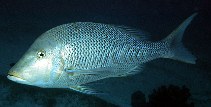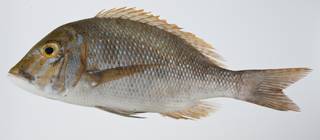WoRMS taxon details
Lethrinus nebulosus (Forsskål, 1775)
212081 (urn:lsid:marinespecies.org:taxname:212081)
accepted
Species
Lethrinus alboguttatus Valenciennes, 1830 · unaccepted
Lethrinus anatarius Richardson, 1845 · unaccepted
Lethrinus aurolineatus MacLeay, 1882 · unaccepted
Lethrinus carinatus Weber, 1913 · unaccepted
Lethrinus centurio Valenciennes, 1830 · unaccepted
Lethrinus choerorynchus (Bloch & Schneider, 1801) · unaccepted
Lethrinus cyanoxanthus Richardson, 1843 · unaccepted
Lethrinus devisianus Whitley, 1929 · unaccepted
Lethrinus erythrurus Valenciennes, 1830 · unaccepted
Lethrinus esculentus Valenciennes, 1830 · unaccepted
Lethrinus fasciatus Valenciennes, 1830 · unaccepted
Lethrinus fraenatus Valenciennes, 1830 · unaccepted
Lethrinus frenatus Valenciennes, 1830 · unaccepted (misspelling)
Lethrinus gothofredi Valenciennes, 1830 · unaccepted
Lethrinus guentheri Bleeker, 1873 · unaccepted
Lethrinus karwa Valenciennes, 1830 · unaccepted
Lethrinus korely Valenciennes, 1830 · unaccepted
Lethrinus maculatus Valenciennes, 1830 · unaccepted
Lethrinus perselectus Whitley, 1933 · unaccepted
Lethrinus scoparius Gilchrist & Thompson, 1908 · unaccepted
Sciaena nebulosa Forsskål, 1775 · unaccepted
Sparus choerorynchus Bloch & Schneider, 1801 · unaccepted
marine, brackish, fresh, terrestrial
(of Sciaena nebulosa Forsskål, 1775) Niebuhr, C. (1775). Descriptiones animalium avium, amphibiorum, piscium, insectorum, vermium; quae in itinere orientali observavit Petrus Forskål. <em>Post mortem auctoris edidit Carsten Niebuhr. Hauniae.</em> 1-20 + i-xxxiv + 1-164, map. [Pisces on pp. x-xix and 22-76]., available online at http://www.biodiversitylibrary.org/item/18564
page(s): 52, xii [details]
page(s): 52, xii [details]
Description Recorded from a temp. range of 26.0-29.0 °C (Ref. 4959). Inhabits nearshore and offshore coral reefs, coralline lagoons,...
Description Recorded from a temp. range of 26.0-29.0 °C (Ref. 4959). Inhabits nearshore and offshore coral reefs, coralline lagoons, seagrass beds, mangrove swamps and coastal sand and rock areas. Adults solitary or in small schools; juveniles form large schools in shallow, sheltered sandy areas. Feeds on echinoderms, molluscs and crustaceans, and to some extent on polychaetes and fish. May have a coppery or iodine taste or smell in the Indian Ocean (Ref. 2295). Also taken with handlines (Ref. 9775). [details]
Froese, R. and D. Pauly. Editors. (2024). FishBase. Lethrinus nebulosus (Forsskål, 1775). Accessed through: World Register of Marine Species at: https://www.marinespecies.org/aphia.php?p=taxdetails&id=212081 on 2024-04-20
Date
action
by
![]() The webpage text is licensed under a Creative Commons Attribution-Noncommercial 4.0 License
The webpage text is licensed under a Creative Commons Attribution-Noncommercial 4.0 License
original description
(of Sciaena nebulosa Forsskål, 1775) Niebuhr, C. (1775). Descriptiones animalium avium, amphibiorum, piscium, insectorum, vermium; quae in itinere orientali observavit Petrus Forskål. <em>Post mortem auctoris edidit Carsten Niebuhr. Hauniae.</em> 1-20 + i-xxxiv + 1-164, map. [Pisces on pp. x-xix and 22-76]., available online at http://www.biodiversitylibrary.org/item/18564
page(s): 52, xii [details]
original description (of Sparus choerorynchus Bloch & Schneider, 1801) Bloch, M.E.; Schneider, J.G. (1801). M.E. Blochii, Systema Ichthyologiae iconibus cx illustratum. Post obitum auctoris opus inchoatum absolvit, correxit, interpolavit Jo. <em>Gottlob Schneider, Saxo. Berolini. Sumtibus Auctoris Impressum et Bibliopolio Sanderiano Commissum.</em> Pp i-lx + 1-584, Pls. 1-110., available online at https://www.biodiversitylibrary.org/bibliography/5750#/summary
page(s): 278 [details]
original description (of Lethrinus guentheri Bleeker, 1873) Bleeker, P. (1873). Description et figure du Lethrinus güntheri Blkr. <em>Archives néerlandaises des sciences exactes et naturelles.</em> v. 8: 153-154, Pl.
page(s): 153, Pl. 2 (bottom fig.) [details]
context source (HKRMS) Hong Kong marine fish database. <em>AFCD.</em> , available online at https://www.hk-fish.net/en/fish/introduction/ [details]
basis of record Froese, R. & D. Pauly (Editors). (2023). FishBase. World Wide Web electronic publication. version (02/2023)., available online at https://www.fishbase.org [details]
additional source Liu, J.Y. [Ruiyu] (ed.). (2008). Checklist of marine biota of China seas. <em>China Science Press.</em> 1267 pp. (look up in IMIS) [details] Available for editors [request]
[request]
ecology source Looby, A.; Erbe, C.; Bravo, S.; Cox, K.; Davies, H. L.; Di Iorio, L.; Jézéquel, Y.; Juanes, F.; Martin, C. W.; Mooney, T. A.; Radford, C.; Reynolds, L. K.; Rice, A. N.; Riera, A.; Rountree, R.; Spriel, B.; Stanley, J.; Vela, S.; Parsons, M. J. G. (2023). Global inventory of species categorized by known underwater sonifery. <em>Scientific Data.</em> 10(1). (look up in IMIS), available online at https://doi.org/10.1038/s41597-023-02745-4 [details]
page(s): 52, xii [details]
original description (of Sparus choerorynchus Bloch & Schneider, 1801) Bloch, M.E.; Schneider, J.G. (1801). M.E. Blochii, Systema Ichthyologiae iconibus cx illustratum. Post obitum auctoris opus inchoatum absolvit, correxit, interpolavit Jo. <em>Gottlob Schneider, Saxo. Berolini. Sumtibus Auctoris Impressum et Bibliopolio Sanderiano Commissum.</em> Pp i-lx + 1-584, Pls. 1-110., available online at https://www.biodiversitylibrary.org/bibliography/5750#/summary
page(s): 278 [details]
original description (of Lethrinus guentheri Bleeker, 1873) Bleeker, P. (1873). Description et figure du Lethrinus güntheri Blkr. <em>Archives néerlandaises des sciences exactes et naturelles.</em> v. 8: 153-154, Pl.
page(s): 153, Pl. 2 (bottom fig.) [details]
context source (HKRMS) Hong Kong marine fish database. <em>AFCD.</em> , available online at https://www.hk-fish.net/en/fish/introduction/ [details]
basis of record Froese, R. & D. Pauly (Editors). (2023). FishBase. World Wide Web electronic publication. version (02/2023)., available online at https://www.fishbase.org [details]
additional source Liu, J.Y. [Ruiyu] (ed.). (2008). Checklist of marine biota of China seas. <em>China Science Press.</em> 1267 pp. (look up in IMIS) [details] Available for editors
ecology source Looby, A.; Erbe, C.; Bravo, S.; Cox, K.; Davies, H. L.; Di Iorio, L.; Jézéquel, Y.; Juanes, F.; Martin, C. W.; Mooney, T. A.; Radford, C.; Reynolds, L. K.; Rice, A. N.; Riera, A.; Rountree, R.; Spriel, B.; Stanley, J.; Vela, S.; Parsons, M. J. G. (2023). Global inventory of species categorized by known underwater sonifery. <em>Scientific Data.</em> 10(1). (look up in IMIS), available online at https://doi.org/10.1038/s41597-023-02745-4 [details]
 Present
Present  Present in aphia/obis/gbif/idigbio
Present in aphia/obis/gbif/idigbio  Inaccurate
Inaccurate  Introduced: alien
Introduced: alien  Containing type locality
Containing type locality
From other sources
Description Recorded from a temp. range of 26.0-29.0 °C (Ref. 4959). Inhabits nearshore and offshore coral reefs, coralline lagoons, seagrass beds, mangrove swamps and coastal sand and rock areas. Adults solitary or in small schools; juveniles form large schools in shallow, sheltered sandy areas. Feeds on echinoderms, molluscs and crustaceans, and to some extent on polychaetes and fish. May have a coppery or iodine taste or smell in the Indian Ocean (Ref. 2295). Also taken with handlines (Ref. 9775). [details]
To Barcode of Life (111 barcodes)
To Biodiversity Heritage Library (1 publication) (from synonym Lethrinus devisianus Whitley, 1929)
To Biodiversity Heritage Library (13 publications) (from synonym Lethrinus karwa Valenciennes, 1830)
To Biodiversity Heritage Library (16 publications) (from synonym Lethrinus centurio Valenciennes, 1830)
To Biodiversity Heritage Library (17 publications) (from synonym Sciaena nebulosa Forsskål, 1775)
To Biodiversity Heritage Library (2 publications) (from synonym Lethrinus cyanoxanthus Richardson, 1843)
To Biodiversity Heritage Library (2 publications) (from synonym Lethrinus gothofredi Valenciennes, 1830)
To Biodiversity Heritage Library (2 publications) (from synonym Lethrinus fraenatus Valenciennes, 1830)
To Biodiversity Heritage Library (2 publications) (from synonym Lethrinus perselectus Whitley, 1933)
To Biodiversity Heritage Library (3 publications) (from synonym Lethrinus scoparius Gilchrist & Thompson, 1908)
To Biodiversity Heritage Library (3 publications) (from synonym Lethrinus korely Valenciennes, 1830)
To Biodiversity Heritage Library (3 publications) (from synonym Lethrinus alboguttatus Valenciennes, 1830)
To Biodiversity Heritage Library (5 publications) (from synonym Lethrinus anatarius Richardson, 1845)
To Biodiversity Heritage Library (5 publications) (from synonym Lethrinus carinatus Weber, 1913)
To Biodiversity Heritage Library (5 publications) (from synonym Lethrinus erythrurus Valenciennes, 1830)
To Biodiversity Heritage Library (5 publications) (from synonym Lethrinus fasciatus Valenciennes, 1830)
To Biodiversity Heritage Library (56 publications)
To Biodiversity Heritage Library (6 publications) (from synonym Lethrinus maculatus Valenciennes, 1830)
To Biodiversity Heritage Library (7 publications) (from synonym Lethrinus aurolineatus MacLeay, 1882)
To Biodiversity Heritage Library (9 publications) (from synonym Lethrinus esculentus Valenciennes, 1830)
To Biological Information System for Marine Life (BISMaL)
To Biological Information System for Marine Life (BISMaL) (from synonym Sciaena nebulosa Forsskål, 1775)
To European Nucleotide Archive (ENA)
To FishBase (from synonym Lethrinus aurolineatus MacLeay, 1882)
To FishBase
To FishBase (from synonym Sparus choerorynchus Bloch & Schneider, 1801)
To FishBase (from synonym Lethrinus alboguttatus Valenciennes, 1830)
To FishBase (from synonym Lethrinus fasciatus Valenciennes, 1830)
To FishBase (from synonym Lethrinus esculentus Valenciennes, 1830)
To FishBase (from synonym Lethrinus devisianus Whitley, 1929)
To FishBase (from synonym Lethrinus erythrurus Valenciennes, 1830)
To FishBase (from synonym Lethrinus centurio Valenciennes, 1830)
To FishBase (from synonym Lethrinus choerorynchus (Bloch & Schneider, 1801))
To FishBase (from synonym Lethrinus cyanoxanthus Richardson, 1843)
To FishBase (from synonym Lethrinus carinatus Weber, 1913)
To FishBase (from synonym Lethrinus anatarius Richardson, 1845)
To FishBase (from synonym Lethrinus perselectus Whitley, 1933)
To FishBase (from synonym Lethrinus maculatus Valenciennes, 1830)
To FishBase (from synonym Lethrinus frenatus Valenciennes, 1830)
To FishBase (from synonym Lethrinus scoparius Gilchrist & Thompson, 1908)
To FishBase (from synonym Lethrinus fraenatus Valenciennes, 1830)
To FishBase (from synonym Lethrinus gothofredi Valenciennes, 1830)
To FishBase (from synonym Lethrinus guentheri Bleeker, 1873)
To FishBase (from synonym Lethrinus karwa Valenciennes, 1830)
To FishBase (from synonym Lethrinus korely Valenciennes, 1830)
To FishBase (from synonym Sciaena nebulosa Forsskål, 1775)
To FishBase images (Lethrinus nebulosus, Australia, by Randall, J.E.)
To GenBank (213 nucleotides; 99 proteins)
To Global Biotic Interactions (GloBI)
To IUCN Red List (Least Concern)
To NMNH Extant Collection (Lethrinus nebulosus USNM 403276 photograph lateral view)
To NMNH Extant Collection (Lethrinus nebulosus USNM 408967 photograph lateral view)
To ITIS
To Biodiversity Heritage Library (1 publication) (from synonym Lethrinus devisianus Whitley, 1929)
To Biodiversity Heritage Library (13 publications) (from synonym Lethrinus karwa Valenciennes, 1830)
To Biodiversity Heritage Library (16 publications) (from synonym Lethrinus centurio Valenciennes, 1830)
To Biodiversity Heritage Library (17 publications) (from synonym Sciaena nebulosa Forsskål, 1775)
To Biodiversity Heritage Library (2 publications) (from synonym Lethrinus cyanoxanthus Richardson, 1843)
To Biodiversity Heritage Library (2 publications) (from synonym Lethrinus gothofredi Valenciennes, 1830)
To Biodiversity Heritage Library (2 publications) (from synonym Lethrinus fraenatus Valenciennes, 1830)
To Biodiversity Heritage Library (2 publications) (from synonym Lethrinus perselectus Whitley, 1933)
To Biodiversity Heritage Library (3 publications) (from synonym Lethrinus scoparius Gilchrist & Thompson, 1908)
To Biodiversity Heritage Library (3 publications) (from synonym Lethrinus korely Valenciennes, 1830)
To Biodiversity Heritage Library (3 publications) (from synonym Lethrinus alboguttatus Valenciennes, 1830)
To Biodiversity Heritage Library (5 publications) (from synonym Lethrinus anatarius Richardson, 1845)
To Biodiversity Heritage Library (5 publications) (from synonym Lethrinus carinatus Weber, 1913)
To Biodiversity Heritage Library (5 publications) (from synonym Lethrinus erythrurus Valenciennes, 1830)
To Biodiversity Heritage Library (5 publications) (from synonym Lethrinus fasciatus Valenciennes, 1830)
To Biodiversity Heritage Library (56 publications)
To Biodiversity Heritage Library (6 publications) (from synonym Lethrinus maculatus Valenciennes, 1830)
To Biodiversity Heritage Library (7 publications) (from synonym Lethrinus aurolineatus MacLeay, 1882)
To Biodiversity Heritage Library (9 publications) (from synonym Lethrinus esculentus Valenciennes, 1830)
To Biological Information System for Marine Life (BISMaL)
To Biological Information System for Marine Life (BISMaL) (from synonym Sciaena nebulosa Forsskål, 1775)
To European Nucleotide Archive (ENA)
To FishBase (from synonym Lethrinus aurolineatus MacLeay, 1882)
To FishBase
To FishBase (from synonym Sparus choerorynchus Bloch & Schneider, 1801)
To FishBase (from synonym Lethrinus alboguttatus Valenciennes, 1830)
To FishBase (from synonym Lethrinus fasciatus Valenciennes, 1830)
To FishBase (from synonym Lethrinus esculentus Valenciennes, 1830)
To FishBase (from synonym Lethrinus devisianus Whitley, 1929)
To FishBase (from synonym Lethrinus erythrurus Valenciennes, 1830)
To FishBase (from synonym Lethrinus centurio Valenciennes, 1830)
To FishBase (from synonym Lethrinus choerorynchus (Bloch & Schneider, 1801))
To FishBase (from synonym Lethrinus cyanoxanthus Richardson, 1843)
To FishBase (from synonym Lethrinus carinatus Weber, 1913)
To FishBase (from synonym Lethrinus anatarius Richardson, 1845)
To FishBase (from synonym Lethrinus perselectus Whitley, 1933)
To FishBase (from synonym Lethrinus maculatus Valenciennes, 1830)
To FishBase (from synonym Lethrinus frenatus Valenciennes, 1830)
To FishBase (from synonym Lethrinus scoparius Gilchrist & Thompson, 1908)
To FishBase (from synonym Lethrinus fraenatus Valenciennes, 1830)
To FishBase (from synonym Lethrinus gothofredi Valenciennes, 1830)
To FishBase (from synonym Lethrinus guentheri Bleeker, 1873)
To FishBase (from synonym Lethrinus karwa Valenciennes, 1830)
To FishBase (from synonym Lethrinus korely Valenciennes, 1830)
To FishBase (from synonym Sciaena nebulosa Forsskål, 1775)
To FishBase images (Lethrinus nebulosus, Australia, by Randall, J.E.)
To GenBank (213 nucleotides; 99 proteins)
To Global Biotic Interactions (GloBI)
To IUCN Red List (Least Concern)
To NMNH Extant Collection (Lethrinus nebulosus USNM 403276 photograph lateral view)
To NMNH Extant Collection (Lethrinus nebulosus USNM 408967 photograph lateral view)
To ITIS


